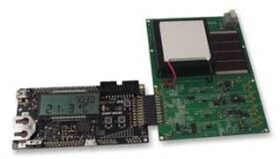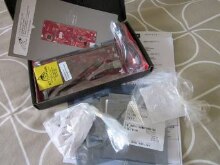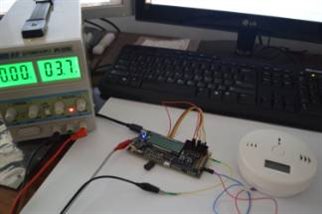 | Enter Your Project for a chance to win an Energy Harvesting Grand Prize for Inspiring the World to Reuse Wasted Energy! | Project14 Home |
| Monthly Themes | ||
| Monthly Theme Poll |
In the Comments Below: What Ideas do You Have for Projects that Harvest Energy from Wasted Energy Sources?
The Project that Does the Best Job of Inspiring the World to Reuse Wasted Energy Wins an Energy Harvesting Kit to Go!
 |
| Buy NowBuy Now |
| The Grand Prize is an energy harvesting board and a Giant Gecko starter kit plus a $200 Shopping Cart! |
The theme this month is Energy Harvesting and it comes from a from fmilburn. Energy harvesting, sometimes called energy scavenging, involves capturing small amounts of energy that would otherwise be lost. The idea is to build projects that involve capturing energy from ambient sources (such solar, wind, vibration, heat, motion, sound) and storing it in an associated storage such as rechargeable batteries, super capacitors, ceramic capacitors, and polymer capacitors. Also, share your interest in Energy Harvesting in Project14 | What Type of Energy Harvesting Do You Find Most Interesting? Because this is a very promising eco-friendly technology, that is yet to meet its potential, we've added an Energy Development Platform Kit as the Grand Prize for the project that inspires the world (the most) to reuse wasted energy! The kit includes four linear voltage converters that are optimized for different energy sources such as solar, electromagnetic, piezo electric, or thermal energy converters. There's also the usual $100 shopping cart for the 3 first winners. Energy harvesting can be used as an alternative or a supplement to batteries for low-power, lower voltage applications such as a wireless sensor node, where it may be used as a secondary energy source to recharge a battery. It is well suited for applications that require back-up battery, especially in remote or locations that are difficult to reach. The energy that is typically captured is small so its ideal for any low voltage, low-power project such as a wearable or portable device. The goal of energy harvesting developers is to create self-sustaining and/or improve the efficiency of non-sustainable systems.
Harvesting energy from non-conventional sources in the environment has received a lot of attention from researchers looking into how these alternative energy sources can be used for lower power applications. Although energy harvesting involves capturing and storing small amounts of energy, its enough to power wireless sensors and other low-power applications. There's a lot of wasted energy in the environment that could be used to power various circuits as a cheap source of power. When applied to wireless sensor networks and IoT devices, it is an eco-friendly solution that helps eliminate the need for network-based energy and conventional batteries, minimizes costs, and reduces the need for cables and batteries. This makes it advantageous to applications in remote areas, underwater, and other hard to reach places where conventional batteries are not suitable. Industries that look to capitalize on this potential include those looking for both low-voltage and low-power applications such as what is used in medical equipment, consumer devices, portables, transportation, industrial controls, and the military.
Energy that can be harvested by scavengers could be byproducts of natural environmental phenomena (solar, wind, tide), industrial process, and the energy produced by every electronic device or gadget (heat and/or vibrations). During the Solar Power Devices, solar cells were used to capture light from the sun in order to produce energy. This is also known as photovoltaic harvesting. Other methods, that you can explore are thermoelectric (heat) harvesting, piezoelectric (vibration) harvesting, and RF/Electromagnetic Harvesting (excess energy from transmitted communication signals). Below are some common energy harvesting techniques. This list is by no means comprehensive and is just to give you an idea of the different types of energy harvesting techniques you may want to consider for your project.
Photovoltaic Harvesting
Photovoltaic harvesting is the process of turning direct sunlight into electricity. It is the most popular form of harnessing the power of the sun. It is the process of turning direct sunlight into electricity. The photoelectric effect, the ability to create voltage and electric current in material upon exposure to light, was first observed in 1839 by French physicist Edmund Bequere. when he noticed that certain material produces small amounts of electric current when exposed to light. In 1954, the first commercial photovoltaic cell was built by Bell Laboratories. It was a solar battery that was too expensive to be anything but a curiosity. The first serious use of the technology was to provide power aboard a spacecraft during the 1960s. When the energy crisis of the 1970s hit, it began receiving recognition as a power source beyond non-space applications. Today, increased efficiency and affordability has led this eco-friendly technology to be used in everything from powering electronics, cars, commercial buildings, and as a supplement to power grids.
A photovoltaic system works by using solar panels to capture photons from sunlight. Each panel has many solar cells made up of layers of different material. These solar panels each have many solar cells made up of layers of different materials. Semiconductors (usually silicone) are sandwiched between a negative conductor on the top and a positive conductor on the bottom. An anti-reflective coating ensures each cell captures as much light as possible. When photons are captured by the solar sels, they release the the outer electrons of atoms within the semiconductor. An electric current is created from the pathway between the negative and positive conductors. This current is sent to wires that capture the DC electric current and leading to a solar inverter which Beneath that is a semiconductor (usually silicone) sandwiched between a negative conductor on top and a positive conductor on bottom. Once the photons are captured by the solar cell, they begin releasing the outer electrons of atoms within then transforms it into the AC electricity.
Thermoelectric Harvesting
Solar thermal energy is different from the type of energy you get from solar cells using photovoltaic technology. Solar thermal plants use the sun to heat a liquid (usually water) or a gas to a high temperature. Light from the sun is concentrated to create heat which is then used to run a heat engine. The heat engine turns a generator which produces electricity. As such, thermoelectric energy harvesting is dependent mainly on the operation of the thermoelectric generator (TEG). Thermoelectric energy harvesting, is of particular interest in the automotive and industrial industries, where large amounts of heat are wasted.
Piezoelectric Harvesting
Piezoelectricity translates to "electrictity under pressure." Human motion, low-frequency vibrations, and acoustic sounds are all potential sources of piezoelectric energy harvesting. The piezoelectric effect converts kinetic energy in the form of vibrations or shocks into electrical energy. Piezoelectric generators (energy harvesters) offer a robust and reliable solution by converting normally wasted vibration energy in the environment to usable electrical energy. They are ideal in applications that need to charge a battery, super capacitor, or directly power remote sensor systems. Examples of piezoelectric energy harvesting include battery-less remote controls that produce energy from the force of a push of the button, piezoelectric floor tiles that generate energy from the foot traffic, and in California there was an experiment funded to convert heavily trafficked roads to piezoelectric energy.
RF/Electromagnetic Harvesting
The electromagnetic spectrum is an abundant source of free energy, photovoltaic harvesting is one example, RF energy harvesting is another example. It's nothing new. One of the earliest examples of capturing ambient electromagnetic radiation (EMR) dates to the beginnings of the 20th century, with an entirely RF powered radio called the crystal radio. The history of radio begins with RF harvesting and you can read more about this in Project14 | Energy Harvesting: RF Harvesting Using a Crystal (or Fox Hole) Radio! RF is an abundance source of ambient energy for harvesting. Electromagnetic waves can come from satellite stations, wireless internet, radio stations, and digital broadcasts. An RF harvesting system captures and converts electromagnetic energy into usable continuous voltage using an antenna and a rectifier circuit as its fundamental building blocks. Learn more about Electromagnetism in Project14 | The Force of Electromagnetism: Anything from Solenoids, Motors, to Wireless Transfer!
Vibration Harvesting
Vibration energy harvesting is a broad category that involves converting vibration energy to electrical energy. This is possible through several types of technology such as electromagnetic induction or piezoelectric. Typical applications that would benefit from this would be where sensors or measurement instruments are used to gather data and traditional power sources (batteries or cables) are too expensive or impossible to use. For example, a factory using a monitoring system to make sure pumps that supply machinery with water to cool them down, doesn't break down. Using vibration energy as a power source the monitor system can function hassle-free and immediately provide the operator with enough information to perform scheduled maintenance, rather than expensive unscheduled maintenance. Commercially successful vibration energy harvesters based on magnetic induction are limited. An example of vibration harvesting can be seen in what's been called a prototype for the first battery-free cell phone which was done by researchers at the University of Washington. The battery-free phone takes advantage of vibrations that occur whenever a person talks or listens to a call.
Wind Harvesting
Kinetic energy from wind is used to generate electricity or mechanical power. This type of energy is practical as a supplemental source of energy for electrical power grids. Storage for wind energy can have high initial costs and much cheaper to keep wind energy as one piece of a varied and flexible energy grid than to store wind energy.
Finally, if you want to watch an inspiring story about how energy harvesting can be used check out the Netfix movie, "The Boy Who Harnessed the Wind", an inspirational true-story based on the memoir of the Malawian engineer William Kamkwamba. In one memorable scene, he rigs up a radio from several drained power cells so that he and his friends can listen to a soccer game. Although he can no longer pay tuition to pay for school, William strikes up a deal with his science teacher (he blackmails his teacher who has a secret relationship with his sister) who allows allows him to continue attending class and this gives him access to the school library where he learns about electrical engineering and energy production. Using what he has learned he builds a small proof of concept and eventually rigs a full-sized wind turbine to irrigate crops, and become the hero in his famine stricken town.
"After two more weeks of reading this book, I found the most fascinating chapter – the discussion of magnets. I knew about magnets because they were used to make the speakers in radios. I'd busted off a few and taken them to school as toys, moving little slivers of metal around through a piece of paper. But as I read further, I discovered that some magnets – called electromagnets – are used to generate electricity, specifically in simple motors, like those found in a radio." - Except from the Boy Who Harnessed the Wind by William Kamkwamba
.
Better yet, check out the memoir the movie is based on:
Energy harvesting has many exciting applications. While the tiny amount of energy captured by energy harvesting is too small to power your cell phone, having a phone that never needs charging is one step closer thanks to researchers at UW. They recently developed what they are calling the first battery-free cell phone to make calls using ambient power. It works by consuming almost no power, utilizing techniques such as taking advantage of vibrations from the speaker or microphone every time a caller listens or speaks into the phone. Energy is harvested from two separate sources, ambient radio signals transmitted by a base station up to 31 feet away, and power is harvested from ambient light with a tiny solar cell to allow communication with a base station that was 50 feet away.
| Key Event | Date |
|---|---|
| Contest Launches: | 14th in August 2019 |
| Qualifier Doc: | 4th in October 2019 |
| Contest Closes / Volunteer Judging: | 14th in October 2019 |
| Winners Announcement: | 21st in October 2019 |
Your Chance to Win
| Be Original | Stick to the Theme |
|---|---|
|
|
| List the Steps | Submit Video Proof |
|
|
Your Project Examples
| Energy Harvesting | |
|---|---|
| Building a Solar Charger | Tilt Solar Light |
| |
| Energy Harvesting | |
|---|---|
| Carbon Monoxide Detector: The Road So Far | Putting it all together: hardware and software for harvesting! |
| |
Your Prizes
| One Grand Prize Winner Wins an Energy Harvesting to Go Kit + a $200 Shopping Cart | Three First Place Winners Win a $100 Shopping Cart |
|---|---|
|
|
 |  |
| Buy NowBuy Now | |
| IC-744885IC-744885 is a development platform for Energy Harvesting Solution To Go which provides very easy access to energy harvesting technologies. The transfer of this solution to the development of a batteryless product is made easy by the right selection of components, schematics and software examples. The two basic parts of the kits are an energy harvesting board and the Giant Gecko starter kit. There are four linear voltage converters on the multi source energy harvesting board. They are optimized for different energy sources like for solar, electromagnetic, piezo electric or thermal energy converters. The energy harvesting board provides an integrated solar cell and a thermo generator for immediate evaluation. | |
|
|
Your Project, Your Ideas!
| About Project14 | Directions |
|---|---|
Every month you'll have a new poll where you'll get to decide an upcoming project competition, based on your interests, that will take place a couple of months in advance. Themes are broad in scope so that everyone can participate regardless of skill set.
What are Monthly Themes?
What are Monthly Theme Polls?
| Step 1: Log in or register on element14, it's easy and free. Step 2: Post in the comments section below to begin a discussion on your idea. Videos, pictures and text are all welcomed forms of submission. Step 3: Submit a blog post of your progress on your project by the end of the month. You are free to submit as many blog entries as you like until the beginning of the next theme.
Be sure to include video proof of your project!
Visit: Energy Harvesting or tag your project blog EnergyHarvestingCH
You have until October 14th End of Day to submit your completed project!
A jury consisting of your peers will judge project submissions! |
In the Comments Below: What Ideas do You Have for Projects that Harvest Energy from Wasted Energy Sources?
The Project that Does the Best Job of Inspiring the World to Reuse Wasted Energy Wins an Energy Harvesting Kit to Go!






Top Comments
-

calboy102
-
Cancel
-
Vote Up
+2
Vote Down
-
-
Sign in to reply
-
More
-
Cancel
-

dougw
in reply to calboy102
-
Cancel
-
Vote Up
+1
Vote Down
-
-
Sign in to reply
-
More
-
Cancel
-

calboy102
in reply to dougw
-
Cancel
-
Vote Up
+2
Vote Down
-
-
Sign in to reply
-
More
-
Cancel
-

genebren
in reply to calboy102
-
Cancel
-
Vote Up
0
Vote Down
-
-
Sign in to reply
-
More
-
Cancel
-

calboy102
in reply to calboy102
-
Cancel
-
Vote Up
+2
Vote Down
-
-
Sign in to reply
-
More
-
Cancel
Comment-

calboy102
in reply to calboy102
-
Cancel
-
Vote Up
+2
Vote Down
-
-
Sign in to reply
-
More
-
Cancel
Children